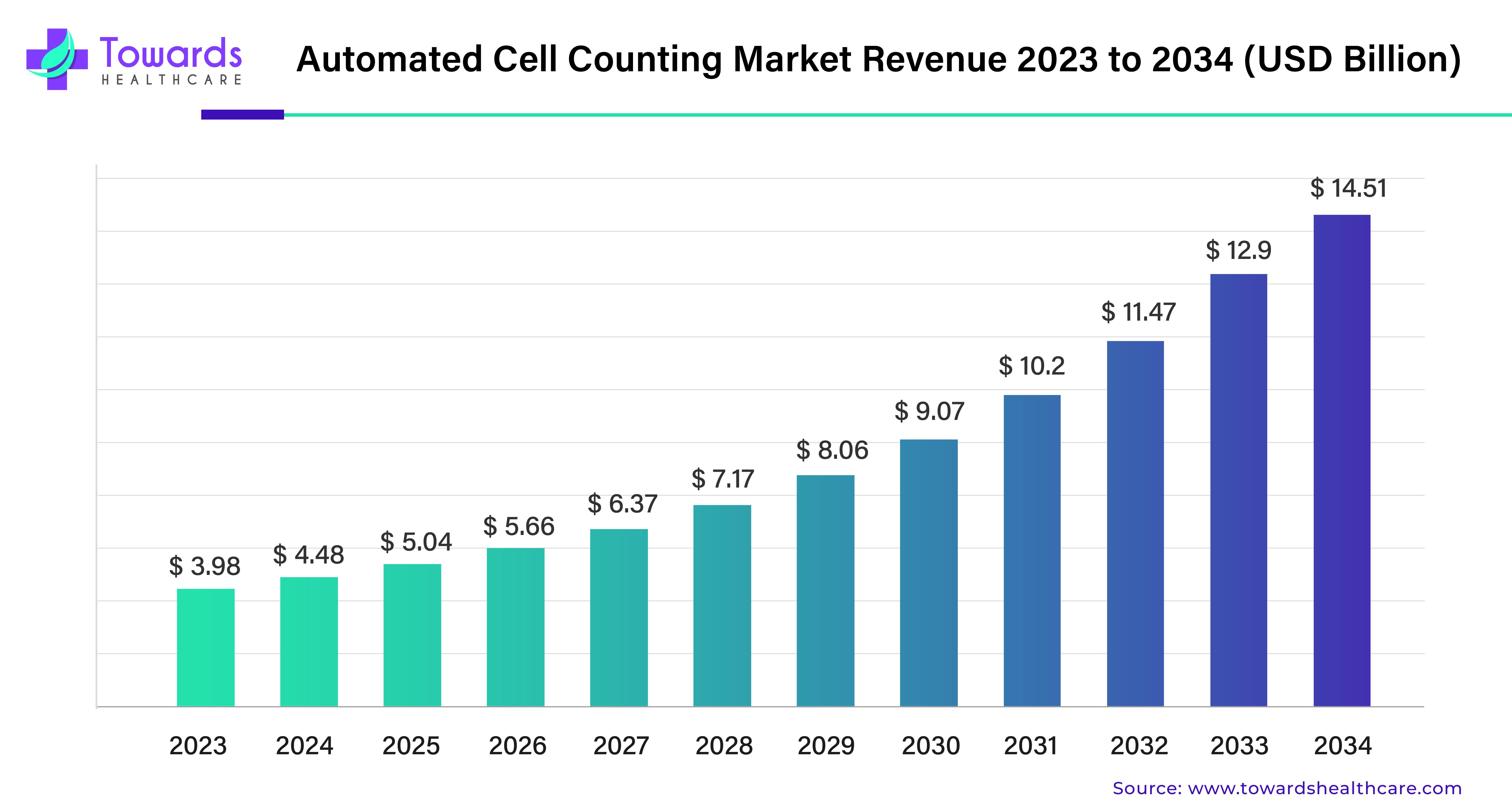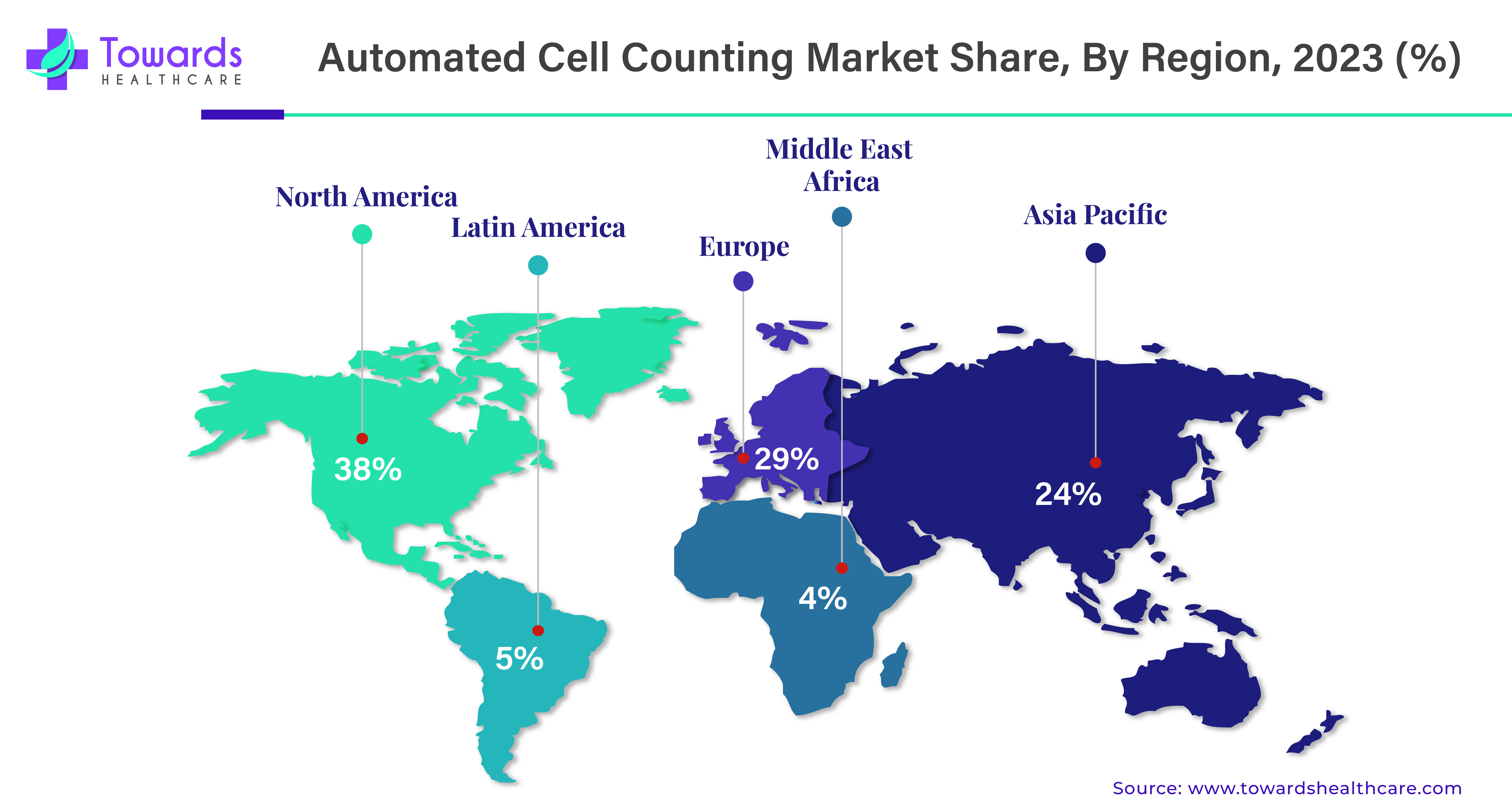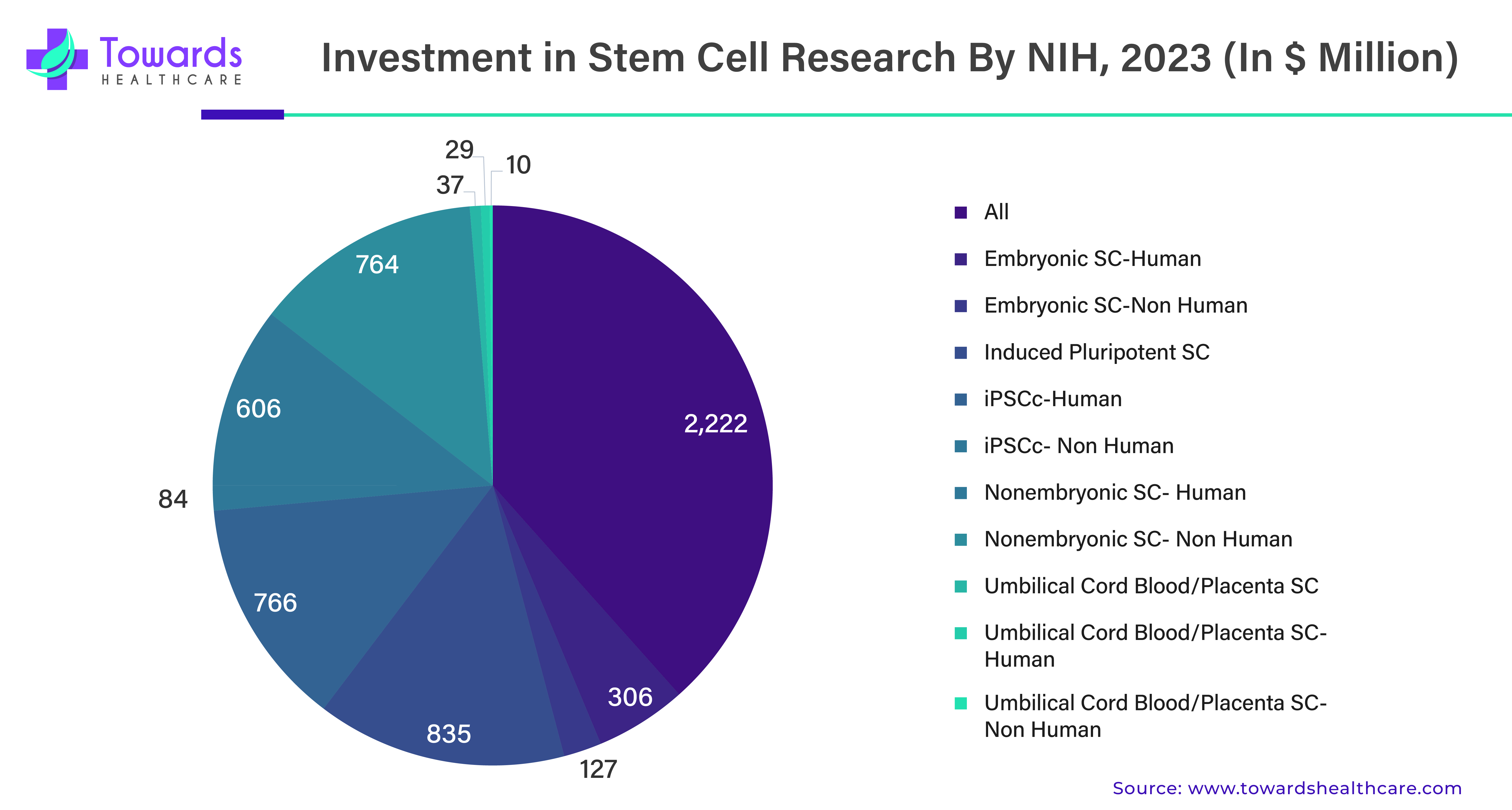April 2025

The global automated cell counting market was estimated at US$ 3.98 billion in 2023 and is projected to grow to US$ 14.51 billion by 2034, rising at a compound annual growth rate (CAGR) of 12.48% from 2024 to 2034. Cell counting is needed in cell culture applications, monitoring of cell culture, development of cell-based assays, and many other processes associated with cell counting, which promotes the growth of the market.

Cell counting is an important process needed in various cell-based assays, cell-based applications and cell cultures. Cell counting helps analyze cell proliferation and cell viability, optimize cell culture, and prepare cell-based assays. Cell counting can be done both manually and automatically. Manual cell counting is time-consuming, hectic, and prone to human error. Therefore, automated cell counting is mostly used in experiments. Automated cell counting is more accurate, reliable, and quick than manual counting. The data generated in automated cell counting can be stored and exported for further use. Image-based counters, coulter counters, and flow cytometers are some of the types of automated cell counters. Automated cell counters are an integral part of biopharmaceutical and bioprocessing companies due to strict regulatory controls. As the demand for biopharmaceuticals grows, so will the need for automated cell counters. In the future, with advancements in technology, automated cell counters will come with more features and better overall performance.
AI has become an integral part of almost all fields and is changing the way things used to function. Like other sectors, the automated cell counting market has also integrated AI to improve its functioning. With the help of AI, the prediction of cell number and distribution has become quicker. The use of AI software in cell counters has reduced the cost of replacing expensive hardware. AI not only helps in counting cells, but it is also capable of differentiating between different cells, which is beneficial in analyzing contamination or debris.
For instance,
| Company Name | DeNovix Inc. |
| Headquarters | Wilmington, DE, U.S., North America |
| Recent Development | In July 2024, DeNovix Inc. developed a hepatocyte app on the CellDrop software, which was developed for cell counting. CellDrop is budget-friendly software that is accessible to all laboratories. It is the first of its kind used for designed for counting cells. The app is based on an automated cell counter machine learning algorithm. Because CellDrop does not require cartridges or disposable slides, the cost and plastic use are reduced significantly. Machine learning will ensure that cell counting is consistent, easy, and fast. |
| Company Name | HORIBA Medical |
| Headquarters | Kyoto, Japan, Asia Pacific |
| Recent Development | HORIBA Medical launched the HELO 2.0 high-throughput automated hematology platform in January 2024. The platform is approved by CE-IVDR and is an updated version of the original platform based on customer needs. The platform provides efficient and flexible hematology solutions, which also include cell counting. In a single run, leukocytes are measured, and complete blood count and DIFF results can be generated. Apart from this, HELO 2.0 is also eco-friendly and reduces environmental impact. |
| Cell and Gene Therapy R&D Projects Supported by Indian DBT from 2020-2024 | |
| Output | Number |
| Scientists Supported | 228 |
| Projects Supported | 144 |
| Manpower Supported | 307 |
| Publications | 105 |
| Patents Filed/Granted | 7 |
| Technologies/Products Developed | 6 |
| Workshop/Training Programs Organized | 5 |
With the era of human cell culture, researchers have started relying on human-cell-based experiments for testing drugs and therapeutics because they provide more accurate results than animal models. Apart from this, to better understand the functioning of human cells and their genetic material, diseases, and cell culturing are studied. All of these require a cell-counting process, which is driving the automated cell counting market. With the growing demand for personalized medicines and the growing prevalence of rare disorders, there has been an increase in the demand for cell-based therapies. A new field has also emerged called “Translational Research,” in which stem cells are used for studying and developing stem-cell-based therapies. Automated cell counting becomes necessary in developing such therapies to understand cell proliferation, viability, and the appropriate number of cell counts needed for the therapy.
For instance,
Technological advancement is a continuous process. Automation, machine learning, and artificial intelligence have been incorporated into cell counting, which requires additional training for understating and operating. As many professionals lack the proper knowledge and training about using automated cell counters, the automated cell counting market is restrained. A lack of knowledge can lead to technical issues, struggles in equipment setup, and difficulty in performing routine maintenance. Improper training can also lead to undermining the integrity of the data, which then raises ethical concerns. It becomes necessary for the manufacturers to provide detailed manuals for using the devices, and every laboratory and institution should provide regular training that will keep the users up-to-date with the technology and knowledge.
Cloud-based cell counting creates new opportunities for the automated cell counting market’s growth. Cloud-based devices have now become an integral part of daily lives as these devices provide the ability to share, store, and transfer large amounts of data at a low cost and in a less complex manner. With the cloud, consistent data will be generated and transferred across different users. Another advantage the cloud-based system provides is reducing the running time of complex algorithms that are used in automated cell counters. In the future, cloud-based systems will be used even more because more data will be generated using automated cell counters, and more complex algorithms will be developed for better functioning.
By product, the consumables & accessories segment held the dominant share of the automated cell counting market in 2023. Consumables and accessories are extra resources needed for cell counting. Consumables include reagents, kits, media, strains, dyes, solutions, buffers, etc. Depending upon the type of cells, different consumables are used to have desirable outcomes. Accessories include slides and reusable slides, needles, plates, spreaders, loops, strainers, pipettes, and flasks. Consumables are used to prepare cell samples, and the sample is mounted on slides for cell counting. The dominance of consumables and accessories is due to continuous and repetitive use for counting cells.
For instance,
By application, the cell line development segment dominated the automated cell counting market in 2023. Cell lines are used in various applications in pharmaceuticals, healthcare, and biotechnology. These applications include the development of biologics (antibodies and proteins), genetic studies, disease studies, drug screening, gene & cell therapies, vaccine production, plasmid production, and so on. Cell counting becomes an essential part of the process because the proper number of cells, viability testing, and contamination in cell lines can be analyzed with the help of automated cell counting. Cell counting in cell line development is needed during primary culture, cell culture analysis, transfer of cell lines for proliferation, storage in biobanks, and downstream processes. Automation makes it easier for users to conduct cell counting during all these steps with better accuracy and in less time.
For instance,
The stem cell research segment is anticipated to grow at the fastest rate in the automated cell counting market by application during the forecast period. Stem cells are undifferentiated cells, which gives them the ability to differentiate into different types of cells. Research associated with stem cells has grown in recent years, and a new field of research has developed called “Translational Research.” Embryonic, non-embryonic, induced pluripotent (iPSCs), cord blood, amniotic fluid, and bone marrow are some of the stem cells used in research. Stem cells can be used to replace damaged cells/tissues, perform organ correction, conduct genetic studies, studies related to how diseases occur, and test the safety and effectiveness of new drugs.
For instance,
By end-use, the pharmaceutical & biotechnology companies segment dominated the automated cell counting market in 2023. Cell counting is an integral part of cell line development. Both pharmaceutical and biotechnology companies use automated cell counting during various upstream, downstream, and research processes. All the major cell-related experiments are conducted by pharmaceutical and biotechnology companies in order to provide better drugs and therapeutics.
For instance,

By region, North America dominated the automated cell counting market share by 38% in 2023. North America is known for having major market players, technological advancements, advanced infrastructure, and continuous research and development in the field of healthcare. With the growing need for cell-based therapies, North America is taking major steps to provide support for research and experiments. In order to develop personalized medicines, market players and government institutions are investing their time, efforts, and finances in conducting stem-cell research.
For instance,

The U.S. is a major contributor to the growth of the automated cell counting market due to technological advancements and a growing number of R&D. The country also has various regulatory bodies like the FDA, which ensures that all regulatory compliances are followed and the research activities are conducted properly. Apart from this, the FDA also provides guidance and resources for conducting experiments. For instance, from 2022-2024, the FDA has been involved in around 8 cell-based therapies, and the FDA is responsible for overseeing everything. As of March 2023, the FDA has approved 38 cell and gene therapies.
Canada is the second-largest contributor to North America’s automated cell counting market by investing its resources in cell-based research. The researchers and scientists in Canada are all working towards solving several challenges that can benefit everyone.
For instance.
By region, Asia Pacific is expected to grow at the fastest rate during the forecast period. The automated cell counting market in the Asia Pacific is driven by China, Japan, India, and South Korea. China's and India’s growing population is a major contributor to the growth of the market as the population demands more therapeutics and cell-based products.
There is a growing demand for CAR T-cell therapies in China, as well as market players, and the Chinese government is taking initiatives to fulfill that demand. According to a research report, a total of 868 clinical trials were assessed, among which the majority of CAR-T cell clinical trials are being conducted in China. This is due to the growing incidents of solid tumors in China, which is creating urgent unmet medical needs.
India is also contributing significantly to the market’s growth. The country has an Institute for Stem Cell Science and Regenerative Medicine. Till now, the Institute has made progress in establishing research facilities and state-of-the-art research laboratories, allotting staff & professionals for research, developing well-funded research programs, and providing procedures and policies.
By Product
By Application
By End-use
By Region
April 2025
April 2025
April 2025
April 2025